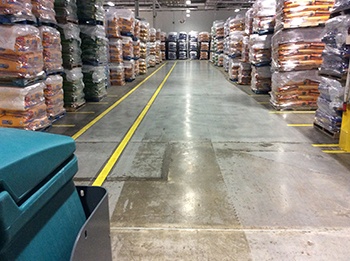 Floor surface preparation is likely the most important step in applying industrial floor coatings. Whether that coating’s purpose is to waterproof, protect from impacts, add friction, or serve a decorative function, it can physically and chemically fail as a result of an improper surface preparation.
Floor surface preparation is likely the most important step in applying industrial floor coatings. Whether that coating’s purpose is to waterproof, protect from impacts, add friction, or serve a decorative function, it can physically and chemically fail as a result of an improper surface preparation.
To ensure that our customers get only the highest-quality floor coating applications and an extended service life, we require that the surface intended for the coating is adequately prepared before performing the job.
Bond Failure
In order to inform you of the possible complications that can arise from an unprepared surface, we are going to present several problems that can occur as a result of negligent or inadequate floor surface preparation.
The foremost concern is that the coating will fail to adhere to the surface as intended. Coatings that have adhesion problems will become separated from the surface, creating a number of physical symptoms. Peeling, pitting, bubbling, cracking, and other similar issues will often begin manifesting themselves within a few weeks of the application. Some surfaces that have been partially prepared will see coating failures after a number of years — a long duration, but still not quite as long as the intended service life.
Bond Failure Causes
There are a number of conditions that can cause an epoxy, polyurethane or similar floor coating to experience premature bond failure:
- Moisture is a common source of bubbling or shifting where the coating makes contact with the flooring
- Oils such as animal fat, machine grease or other substances will cause an adhesive bond to detach quite quickly
- Residual Surface Treatments such as adhesives, solvents, caustics and acids will all react to the epoxy and disrupt its curing and adhesion process. Unremoved sealers or curing compounds are a common source of this problem
- Dirt or other free surface contaminates will inhibit proper adhesion the coating needs with the surface
Cracks, Pitting and Ripples
Even when a floor coating manages to successfully form a chemical adhesive bond with the floor surface, it can still display physical irregularities as a result of inadequate floor surface preparation.
Cracks and pitting most likely occur when concrete or hard surfaces are not completely repaired and finished level before applying the coating. Small irregularities in the floor shape transfer to the coating as the material settles and surface pressure forces the coating into grooves. Concrete in particular should be repaired of all spalling and cracks to prevent this problem.
Uneven coating, bubbles, or ripples can occur when the texture of the prepared surface is not enough for the coating to “grip” onto while being applied. As the coating cures, it may shift if the surface is too smooth, creating subtle ripples and variations in thickness. The opposite problem can arise when dirt or other abrasives are left before application.
Physical problems are not as concerning as chemical ones since the base-level adhesion is still functioning, but over time cracks, ripples, pits, and bubbles can cause uneven wear and unsatisfactory performance.
To uphold our promise to our clients that we only apply the best quality, longest-lasting coatings in any industrial or commercial setting, we thoroughly inspect the floor surface before performing any coating application job. Should we notice any problems, we can make suggestions or offer our own floor preparation services before beginning. Our clients should expect only the best, because that is what we intend to give them.

